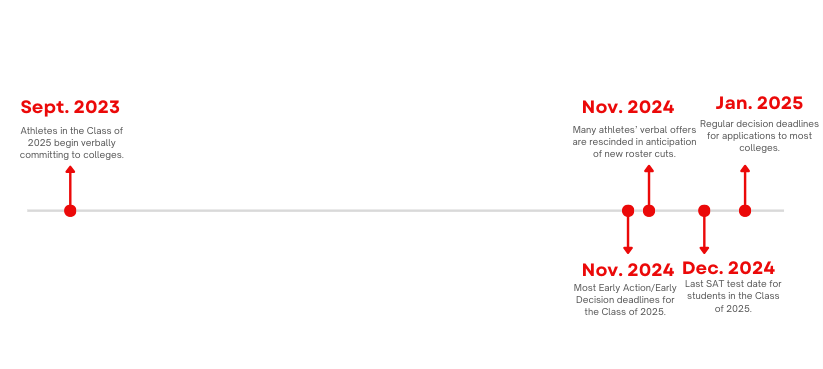In McLean’s class of 2024, 17 athletes went on to play in college, 11 of whom committed to Division I schools. Beginning with the class of 2025, it will be much more difficult for high school athletes to achieve this success. As a result of the pending House v. NCAA lawsuit, the NCAA will be establishing new roster limits, and DI teams will be forced to cut the size of their current rosters, in some cases by nearly 20%.
“It’s going to be a lot harder to get recruited because of the decrease in roster spots,” senior soccer defender Calypso Rolly said. “Schools just aren’t looking for that many [new] players. On the other hand, the ones who do get recruited will have a higher chance of getting more scholarship money.”
Financial aid is the center focus of the lawsuit. In May 2024, the NCAA agreed to a $2.8 billion settlement in retroactive payments to athletes who were unable to earn money in college prior to the name, image, and likeness (NIL) deals. This case will benefit future college athletes as well, with the removal of scholarship limitations being a significant aspect of the pending agreement. However, to compensate these athletes, the settlement is expected to include heavy roster cuts across most sports. As DI schools await the lawsuit results, many are already reducing their rosters in anticipation of the new limits.
“Two of my current [soccer] teammates got their offers rescinded because some college teams are over [the new] limit and recruited too many girls,” Rolly said. “It’s [awful] because they committed to their dream schools and then a year later got told they no longer have a spot. [Because] it’s so late in the recruiting process, most teams don’t want to recruit other players so it’s really hard for [them] to find [new] schools.”
Not only is it difficult for formerly committed athletes to play elsewhere, the timing of these cuts significantly hinders their chances of getting into any college, even academically. With the changes happening so late in the year, seniors who were committed and haven’t applied to colleges or taken the SAT find themselves in a stressful situation.
“I have heard about people who have been cut from rosters, even people who are close to me,” junior lacrosse goalie Brooke Buursink said. “Depending on the timing, you’re going to miss college applications, [early decision], and the ability to transfer to another school. That’s going to ruin your whole process.”
Juniors who have verbally committed are seeing the effects as well. Despite still being able to apply to colleges on time, the circumstances are no less frustrating for them. With less spots on the team, every player is on the chopping block, especially specialized positions.
“I did worry about it, especially because I’m in such a restricted position where it’s only one per team,” Buursink said. “If they were going to cut somebody, it would most likely be a goalie position, so it did worry me going through the process.”
However, for those who secure their place on a DI roster, the potential for scholarship money is higher. The scholarship cap is being replaced by roster-based limits, so all committed athletes will be able to receive scholarships, and schools can now compensate athletes directly through revenue-sharing agreements. However, these benefits ultimately come at the expense of many aspiring DI commits.
“It will definitely be harder to commit, especially with the bigger teams like football where it’s significantly cut to a limited roster,” Buursink said. “I think it’ll be much more rigorous in order to get to a DI spot.”









Andrew Egorin • Dec 19, 2024 at 9:36 am
Great article! However, I don’t quite get why schools need to cut recruiting spots to pay for the $2.8 billion; shouldn’t Class of 2025 recruits still be admitted, just maybe without scholarship dollars? Why is there an outright cap on rosters? Surely “having a big team” has almost no effect on costs, while “giving out lots of scholarships” is more understandable.